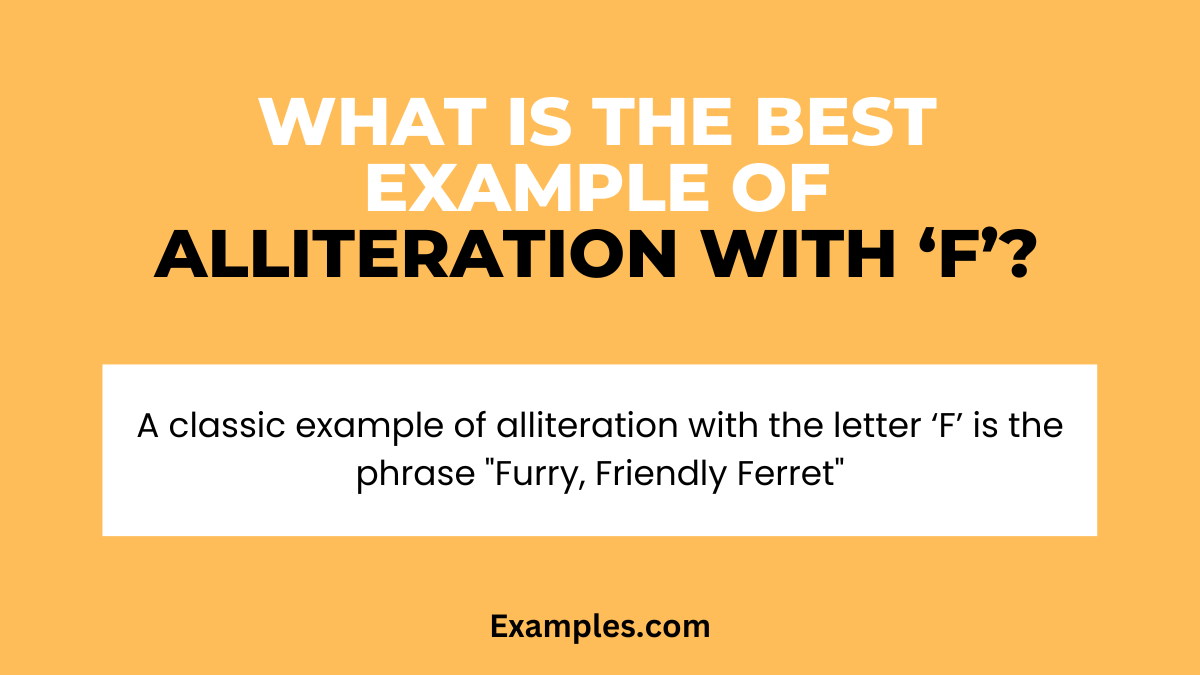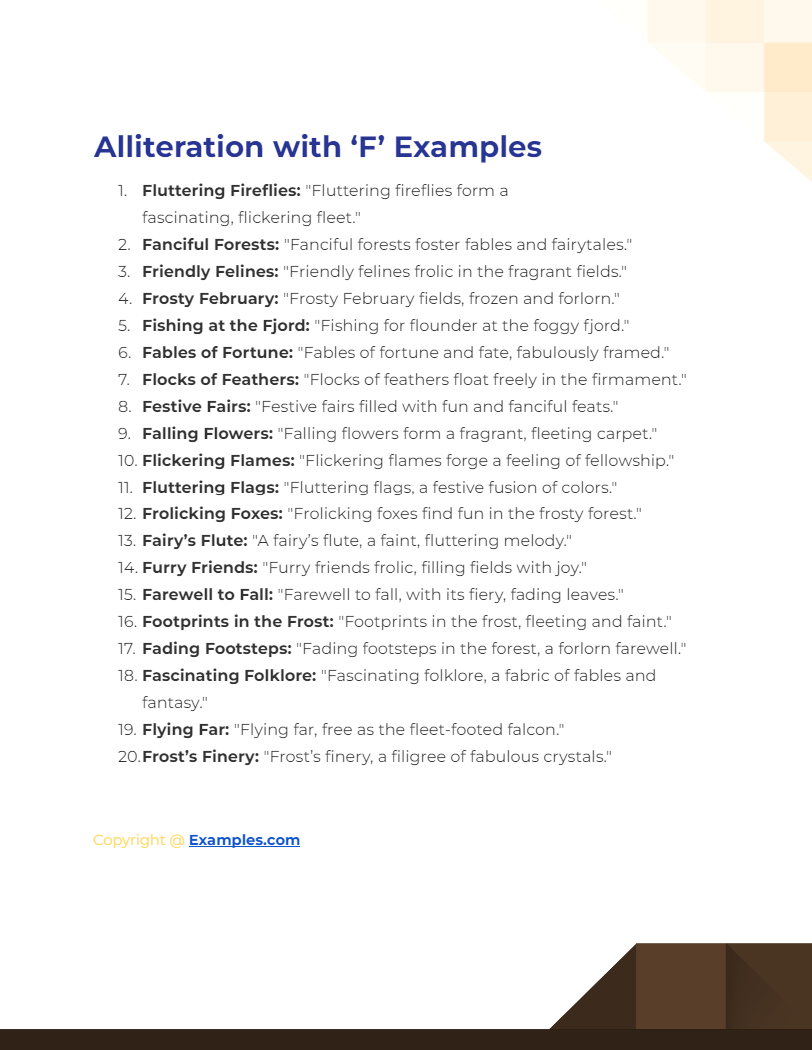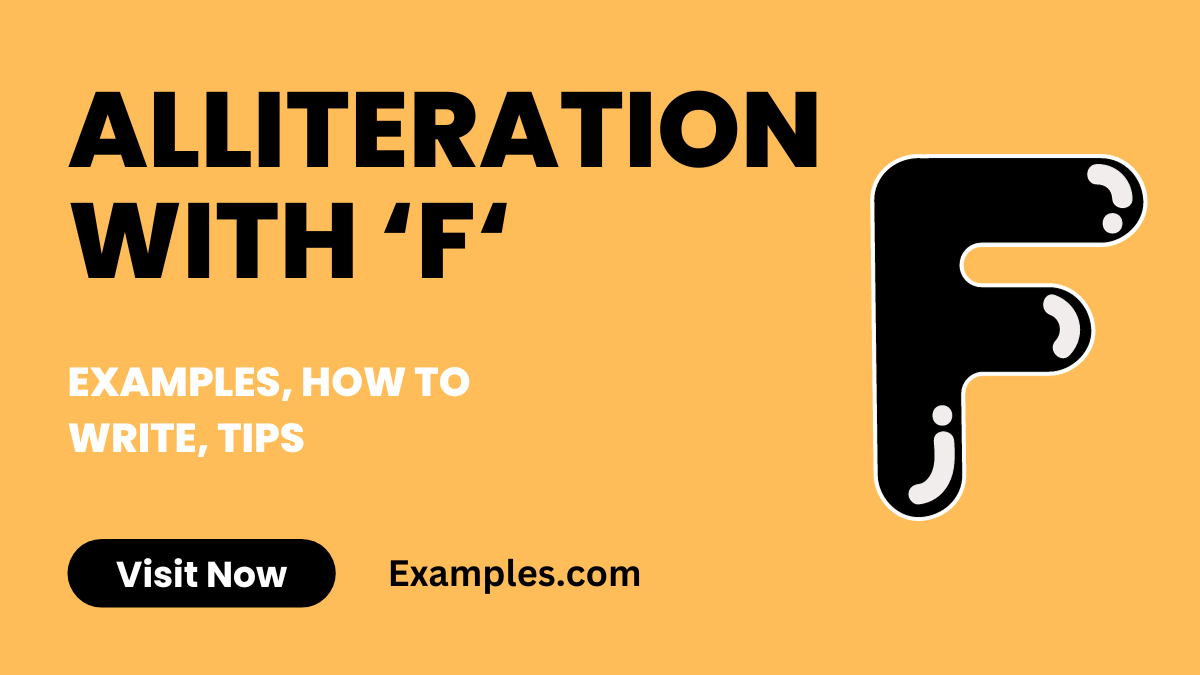Alliteration with F
Alliteration with the letter ‘F’ is a fascinating and effective literary device that enhances the rhythmic quality and auditory appeal of a text. Characterized by the repetition of the ‘F’ sound at the start of closely connected words, it can evoke a range of emotions and create vivid imagery in the reader’s mind. Mastering alliteration and assonance with ‘F’ involves carefully choosing words that start with the ‘F’ sound and placing them strategically to create a memorable and impactful sentence or phrase. This technique is popular in poetry, prose, and even in everyday speech, as it can make language more engaging and lyrical. Understanding and utilizing alliteration with ‘F’ can add a layer of depth and creativity to writing, making it more evocative and appealing to the audience.
Download Alliteration with 'F' Examples
Download Alliteration with 'A' to 'Z' Examples
What is the Best Example of Alliteration with ‘F’?

Example: A classic example of alliteration with the letter ‘F’ is the phrase “Furry, Friendly Ferret”
Meaning: Alliteration is a literary device that involves the repetition of consonant sounds at the beginning of consecutive words in a sentence or phrase. In the example “Furry, Friendly Ferret,” the consonant ‘F’ is repeated at the start of each word. This technique not only creates a musical and rhythmic quality to the phrase but also makes it more memorable and engaging. Easy Alliteration is commonly used in literature, poetry, and advertising to add emphasis, create wordplay, and enhance the overall appeal of the language used.
20 Alliteration with ‘F’ Examples

Download Alliteration with 'F' Examples in PDF
Alliteration using the letter ‘F’ forges a fascinating fusion of fun, fantasy, and finesse in language. The ‘F’ sound, with its soft and sometimes whimsical quality, can create phrases that are both melodious and meaningful. These examples demonstrate how ‘F’ alliteration in rhymes can be used to paint vivid pictures, tell stories, or simply add a playful twist to language. Here are 20 unique examples of alliteration with ‘F’, each accompanied by a rhyme title that captures the spirit of the alliteration.
- Fluttering Fireflies “Fluttering fireflies form a fascinating, flickering fleet.”
- Fanciful Forests “Fanciful forests foster fables and fairy tales.”
- Friendly Felines “Friendly felines frolic in the fragrant fields.”
- Frosty February “Frosty February fields, frozen and forlorn.”
- Fishing at the Fjord “Fishing for flounder at the foggy fjord.”
- Fables of Fortune “Fables of fortune and fate, fabulously framed.”
- Flocks of Feathers “Flocks of feathers float freely in the firmament.”
- Festive Fairs “Festive fairs filled with fun and fanciful feats.”
- Falling Flowers “Falling flowers form a fragrant, fleeting carpet.”
- Flickering Flames “Flickering flames forge a feeling of fellowship.”
- Fluttering Flags “Fluttering flags, a festive fusion of colors.”
- Frolicking Foxes “Frolicking foxes find fun in the frosty forest.”
- Fairy’s Flute “A fairy’s flute, a faint, fluttering melody.”
- Furry Friends “Furry friends frolic, filling fields with joy.”
- Farewell to Fall “Farewell to fall, with its fiery, fading leaves.”
- Footprints in the Frost “Footprints in the frost, fleeting and faint.”
- Fading Footsteps “Fading footsteps in the forest, a forlorn farewell.”
- Fascinating Folklore “Fascinating folklore, a fabric of fables and fantasy.”
- Flying Far “Flying far, free as the fleet-footed falcon.”
- Frost’s Finery “Frost’s finery, a filigree of fabulous crystals.”
Alliteration Sentence Examples with ‘F’
Alliteration sentences with ‘F’ often feature a fluid, flowing sound that can add a touch of finesse and fantasy. The ‘F’ sound, whether soft or forceful, lends itself well to creating memorable and engaging phrases. Here are three examples:
- “Fierce falcons flew fearlessly through the foggy fjords.”
- “Fiona’s fluffy felines frolicked in the fragrant flowers.”
- “Festive fireworks flickered, forming fantastic figures in the sky.”
Alliteration Examples with ‘F’ Words
Alliteration using ‘F’ words creates a fascinating and often whimsical effect in hard alliteration. These examples showcase the versatility and the rhythmic quality of the ‘F’ sound in language. Here are three examples:
- “Frothy foam floats on the fathomless, flowing river.”
- “Flickering fireflies flit through the forest’s fringe at twilight.”
- “Feathery ferns flourish in the fog-laden forest.”
Alliteration Examples with ‘F’ Name
Incorporating names that start with ‘F’ in alliteration adds a personal and often playful element to the literary device. Here are three examples:
- “Frank’s fantastic fish fry filled Friday with fun.”
- “Felicity found fascinating fossils in the forest.”
- “Freddie’s fearless feats fascinated his friends.”
Alliteration Examples with ‘F’ Sound
The ‘F’ sound in alliteration can produce a variety of effects, from light and airy to bold and resonant. These examples demonstrate the diverse applications of the ‘F’ sound in alliterative songs and phrases. Here are three examples:
- “Fluttering feathers fall from the fleeting flock.”
- “Frosty fogs form over the fields at dawn.”
- “Fabled fairies flit through the fragrant fuchsia flowers.”
Alliteration Beginning with ‘F’
Alliteration beginning with ‘F’ sets a distinct tone, often used to create a sense of movement or to add a lyrical touch. Here are three examples:
- “Fast and furious, the fox fled through the forest.”
- “Fresh fruit flavors filled the festive fair.”
- “Frantic footsteps faded into the foggy night.”
Alliteration Poem with ‘F’
Alliteration poems with ‘F’ use the repetitive ‘F’ sound to create a rhythmic and engaging poetic experience. Here are three examples:
- “Falling leaves, fluttering, / Form a carpet, golden, muttering, / Underfoot, they crunch, fluttering.”
- “Foxes frolic in the forest, / Under moonlight, they are the florist, / Painting paths with paws, the softest.”
- “Fields of flowers, brightly festooned, / Fragrances in air, perfumed, / Summer’s song, in colors, crooned.”
How to Write Alliteration with ‘F’?
Writing alliteration answers with the letter ‘F’ involves using words that start with the ‘F’ sound in close proximity within sentences or phrases. This consonantal alliteration can add a lyrical, rhythmic quality to writing. Here’s how to craft effective alliteration with ‘F’:
- Understand the ‘F’ Sound: Familiarize yourself with the sound of the letter ‘F’. It’s a fricative consonant, producing a soft, continuous sound, creating a flowing, often soothing effect in language.
- Choose a Theme: Select a theme or subject for your sentence or piece. The theme guides your choice of ‘F’ words, ensuring relevance and coherence.
- Brainstorm ‘F’ Words: Compile a list of words starting with the ‘F’ sound. A thesaurus can be helpful for finding a variety of words, including adjectives, nouns, and verbs.
- Create Your Phrase or Sentence: Construct a sentence or phrase using your chosen ‘F’ words. Aim for a natural and fluid arrangement that sounds rhythmic when spoken.
- Read Aloud for Rhythm: The effectiveness of alliteration is often best judged audibly. Read your sentence aloud to ensure it has a pleasing rhythm and flow.
- Revise for Impact and Clarity: Edit your sentence for maximum impact. Ensure that the alliteration enhances the message without compromising clarity.
- Incorporate into Your Writing: Integrate your alliterative phrase into your larger text, whether it’s a poem, story, or an essay, to add stylistic flair.
Tips for Using Alliteration with ‘F’
Here are the Tips for Using Alliteration with ‘F’:
- Use Sparingly: Alliteration should enhance, not overwhelm, your writing. Use it to highlight important points or to add a poetic touch but avoid overdoing it.
- Ensure Clarity: While alliteration adds style, clarity should always be your priority. Your sentence should remain clear and easy to understand.
- Vary Word Lengths and Types: Mix short and long ‘F’ words, as well as different types (nouns, verbs, adjectives), for a more interesting and varied rhythm.
- Consider the Mood: The ‘F’ sound can be soft and soothing or fun and playful. Choose words that align with the mood and tone you want to convey.
- Test the Sound: Read your work aloud to catch the rhythm and flow. The auditory impact of alliteration is crucial to its effectiveness.
- Avoid Forced Repetition: Ensure that the repetition of ‘F’ sounds natural and not forced. Forced alliteration can detract from the reader’s experience.
- Explore Different Contexts: Try using alliteration in various forms of writing, from creative to academic, to understand its effect on your work.
By following these guidelines, you can effectively use alliteration figurative language to add a distinctive, rhythmic quality to your writing, making it more engaging and enjoyable for your audience.
What is the Repetition of the ‘F’ Sound?
The repetition of the ‘F’ sound, a key component of alliteration, involves using words that start with the ‘F’ consonant in close proximity within a text. This creates a rhythmic pattern and can significantly enhance the musicality and appeal of language. The ‘F’ sound, being a fricative consonant, produces a soft, continuous noise, which can add a fluid and often soothing or whimsical quality to sentences. This technique is famous in alliterative poetry, prose, tongue twisters, and other forms of creative writing, where the sound and rhythm of words play a crucial role in the overall impact of the piece.
What are the Alliteration with ‘F’ for Kids?
Alliteration for kids uses the repetition of the ‘F’ sound to create engaging and memorable phrases, often for educational or entertainment purposes. These alliterations can make learning fun and help with language development, including vocabulary building and phonetic awareness. Examples suitable for children include simple, playful phrases like:
- “Five fluffy feathers floated down from the sky.”
- “Freddy Frog frolics freely in the forest.”
- “Fiona the fox finds fantastic fruits for lunch.”
Such phrases can be used in children’s books, educational games, and classroom activities to support language learning in an enjoyable way.
What is the Effect of ‘F’ Letter in Alliteration?
The effect of the ‘F’ letter in alliteration is to create a soft, flowing sound that can add a lyrical quality to language. This sound is particularly effective in creating a sense of movement, lightness, or even whimsy. In Alliteration literature, the ‘F’ alliteration can be used to draw attention to certain phrases, emphasize concepts, or enhance the overall auditory experience of a piece. It’s often used to convey a gentle, soothing, or playful tone but can also be employed in more serious contexts to add rhythm and emphasis.
What is the Alliteration ‘F’ Type of?
Alliteration with the letter ‘F’ is a type of consonantal alliteration. It involves the repetition of the ‘F’ consonant sound at the beginning of adjacent or closely connected words. This type of alliteration is noted for its ability to add a rhythmic, flowing quality to writing, making it particularly appealing in poetry and prose where sound plays a significant role in great alliteration. The ‘F’ sound, being soft and continuous, is less abrupt than other consonants, allowing for a smoother transition between words and contributing to the overall harmony and fluidity of the text.


